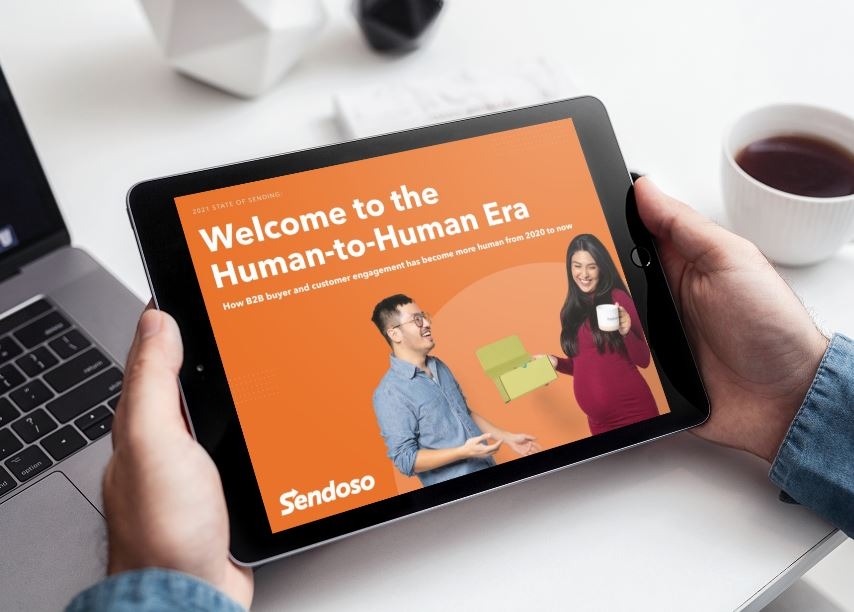As B2B marketers continue to find innovative new ways to keep their audiences engaged, gifting and direct mail strategies have experienced renewed interest. The “2021 State of Sending” report from Sendoso showed B2B marketers taking a more human-to-human (H2H) approach to their engagement efforts, as 88% adopted a customer-centric sending strategy since March 2020.
The resurgence in gifting and direct mail is B2B organizations’ response to virtual buyer burnout, as 80% of revenue leaders surveyed believed their target buyers are digitally fatigued. As a result, 68% struggled to connect with buyers in a digital environment, highlighting the ongoing challenges with digital engagement.
“With the pandemic and all of us being physically isolated from one another, the shift to digital was accelerated even further,” said Kai Ichikawa, VP of Product Marketing at Sendoso, in an interview with Demand Gen Report. “The fatigue people got from the inundation of email and Zoom calls was a catalyst to say, ‘Hey, there has to be more genuine, authentic ways we can talk to our customers, prospects, partners and employees.’”
To address this gap, many marketers realized they needed to customize their marketing strategies, with 92% looking to engage buyers with more personalized content. As a result, organizations turned to gifting and direct mail as potential avenues for revitalizing their marketing mixes to deliver on buyers’ craving for personalized engagement while working from home.
Increasing Buyer Retention Through Personalized Gifts
The research highlighted the impact of personalization on digital B2B buying, with 91% of revenue leaders now believing that building a personal connection with target buyers is critical to closing deals.
Ichikawa explained that successful personalized gifting relies heavily on knowing who the buyer is, what their interests are and the pain points they need addressed. The report highlighted how 83% of respondents reported positive feedback from their gifting and sending strategies, showing that buyers will respond positively to gifts relevant to their personal or business interests.
As a result, B2B organizations developed themes for their gifting strategies to address relevant pain points and topics of interest happening in the buyer’s daily lives. The study showed that 64% of organizations achieved a higher client retention rate with these initiatives. In addition, targeted gifting strategies enabled 54% of respondents to close more deals and 63% to forge deeper client relationships in 2021.
“I think gifting is one of those vehicles that is applicable across your marketing mix, regardless of the stage of the engagement,” he continued. “It shows that you’ve intentionally gone out of your way to think about this gift card, flowers, cupcakes or whatever you send to say, ‘Hey, I want to just say thank you or acknowledge that this relationship has meaning.’ Those gestures really do speak louder than words for buyers or, in this case, equally as loud as words.”
Enhancing Existing Gifting Philosophies With A New Methodology
With the acceleration of digital B2B interactions and most target buyers working from home, organizations were forced to shift the execution of their gifting and direct mail strategies. This shift led to a 60% increase of E-gifts sent to target buyers, partners and employees throughout 2020, following a desire to provide buyers with practical gifts instead of swag. The most popular E-gifts included gift cards to Amazon, Starbucks, Grubhub and Uber/Uber Eats, allowing 70% of recipients to redeem a relevant gift within four days.
Interestingly, direct mail and physical gifting are not completely dead, with some organizations experimenting with target buyer data to increase the accuracy and effectiveness of their direct sending strategies. By leveraging address confirmation tools, organizations saw an 84% increase in responses from buyers, with 65% stating that direct mail helps them stand out against their competitors.
“What used to be a very old school channel in direct mail is actually coming back,” Ichikawa noted, explaining that direct mail and electronic sending strategies are unlikely to disappear from B2B anytime soon. In fact, 79% of revenue leaders plan to implement direct mail or E-gifting strategies over the course of 2021. Additionally, 71% of marketers and salespeople expect the number of gifts sent to buyers to increase over the next 12 months.
“Sending/gifting is just another tool in your toolkit,” said Ichikawa. “If you’re not integrating that as part of a comprehensive strategy, you’re missing a valuable channel that drives engagement and genuine conversation.”
For additional insights into modern gifting and direct mail strategies, check out the full report here.







